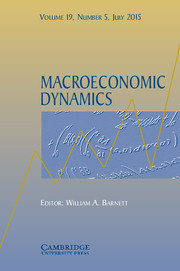
The Quantity Theory Revisited: A New Structural Approach
While the long run relation between money and inflation is well established, empirical evidence on the adjustment to the long run equilibrium is very heterogeneous. In this paper we show, that the development of US consumer price inflation between 1960Q1 and 2005Q4 is strongly driven by money overhang. To this end, we use a multivariate state space framework that substantially expands the traditional vector error correction approach. This approach allows us to estimate the persistent components of velocity and GDP. A sign restriction approach is subsequently used to identify the structural shocks to the signal equations of the state space model, that explain money growth, inflation and GDP growth. We also account for the possibility that measurement error exhibited by simple-sum monetary aggregates causes the consequences of monetary shocks to be improperly identified by using a Divisia monetary aggregate. Our findings suggest that when the money is measured using a reputable index number, the quantity theory holds for the United States.





